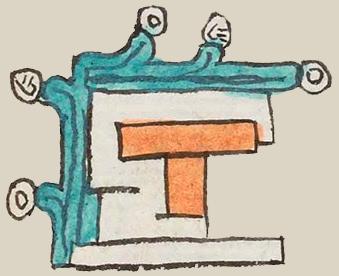Apancalecan (Mdz38r)
This compound glyph for the place name Apancalecan is one of two in the Codex Mendoza, and they are very similar to one another. They both show water (atl) both on and spilling off the roof of a building or house (calli). The water is the usual turquoise blue color with lines if current, with droplets/beads and turbinate shells splashing off the flow. The house is the usual white with terracotta-colored beams comprising the t-shaped doorway, which here faces to the viewer's right. The -can locative suffix is not shown visually.
Stephanie Wood
The phonetics of a + calli point to the acalli, boat. Which may lead to the reading, "Place of the Possessors of Boats." The -e- [really -eh-, with a glottal stop} after "-cal-" supports that possession, athough possession is not shown in any way visually, it is supported by the orthography in the gloss.
Berdan and Anawalt took the approach that this place name referred to people who had houses on canals (apantli), which would have been common in the capital city on the lake, criss-crossed by canals. While the apantli would many times have some containment—a bottom and sides in a cross-section view–this is not 100% the case, as shown by our attestations below, to the right. There, you will see many times where the atl sign stands for apantli, and one apantli sign that was used for atl.
The reading of possessors of houses on canals is supported by references to the use of the term apancalli in Nicaragua, which Alfonso Valle's study of place names suggests were "casas de los apantes," and apantes were "caños de agua." But the latter could refer to gutters or drains, and not just canals.
Another reading is Frances Karttunen's translation of this place name as "Place Where People Have House Boats." In this case apancalli would be a house boat.
Stephanie Wood
apancalecā. puo
Apancalecan, pueblo (see Papanoa, Guerrero, today)
Stephanie Wood
c. 1541, or by 1553 at the latest
Stephanie Wood
houses, buildings, water, shells, architecture, edificios, arquitectura casas, navíos, barcos, lanchas agua, caracoles, nombres de lugares

a(tl), water, https://nahuatl.wired-humanities.org/content/atl
apan(tli), water channel, https://nahuatl.wired-humanities.org/content/apantli
cal(li), house or building, https://nahuatl.wired-humanities.org/content/calli
-e- (possessor suffix), https://nahuatl.wired-humanities.org/content/e-0
-can (locative suffix), https://nahuatl.wired-humanities.org/content/can-2
"Place of House Canals" (Berdan and Anawalt, 1992, vol. 1, p. 171)
"Lugar Donde Gente Tiene Casas Flotantes" o "Lugar Donde Gente Tiene Casas Junto a los Canales"
Codex Mendoza, folio 38 recto, https://digital.bodleian.ox.ac.uk/objects/2fea788e-2aa2-4f08-b6d9-648c00..., image 86 of 188.
The Bodleian Libraries, University of Oxford, hold the original manuscript, the MS. Arch. Selden. A. 1. This image is published here under the UK Creative Commons, “Attribution-NonCommercial-ShareAlike 3.0 License” (CC-BY-NC-SA 3.0).







